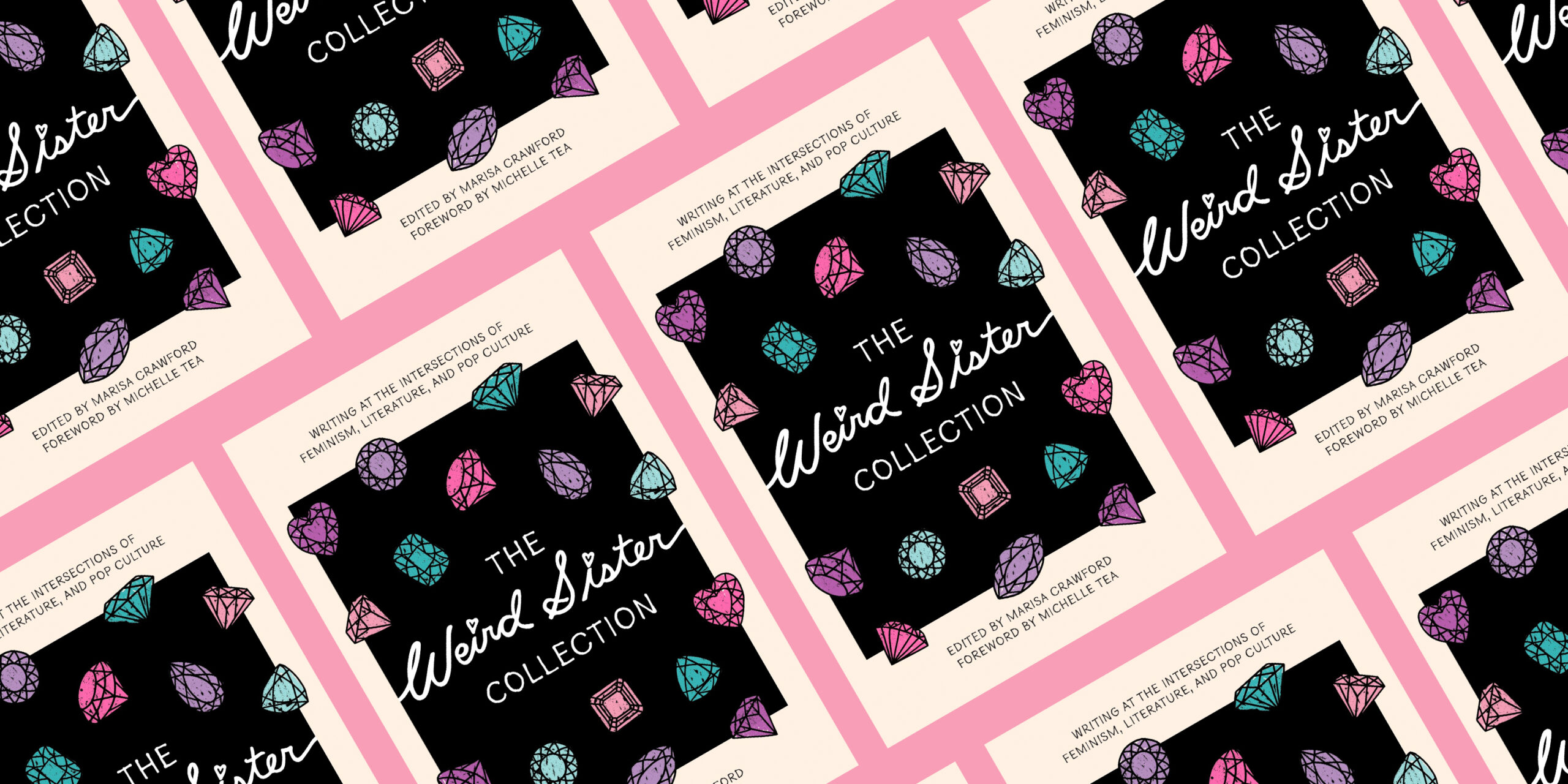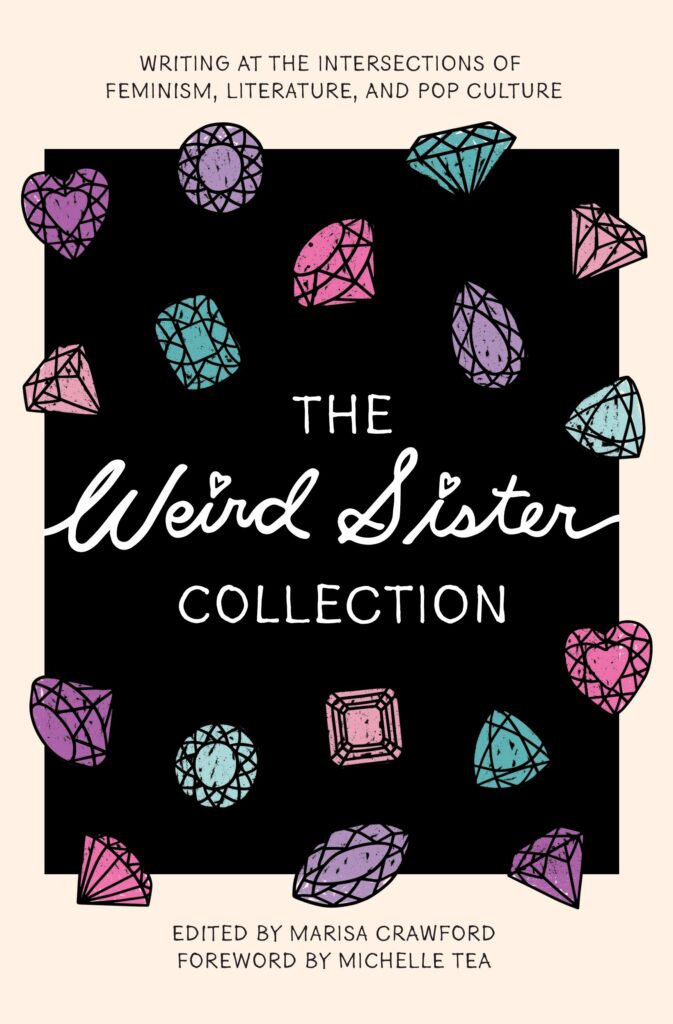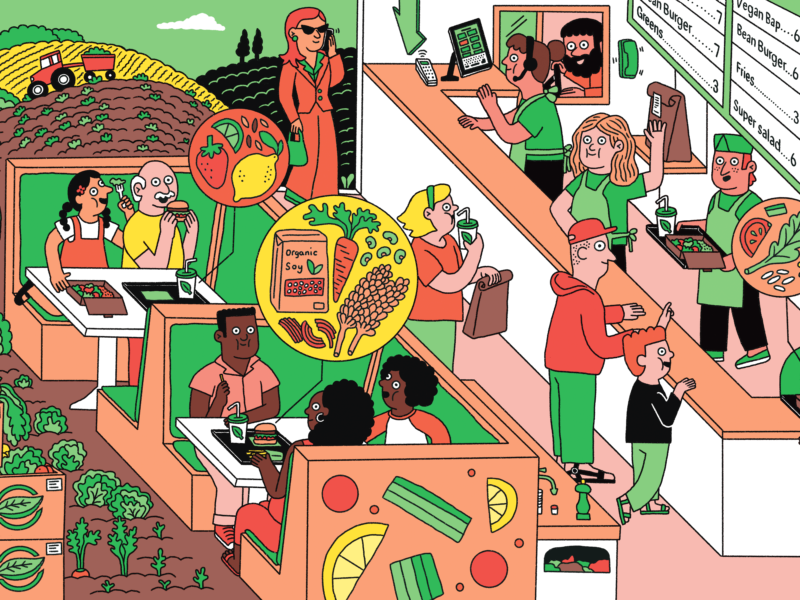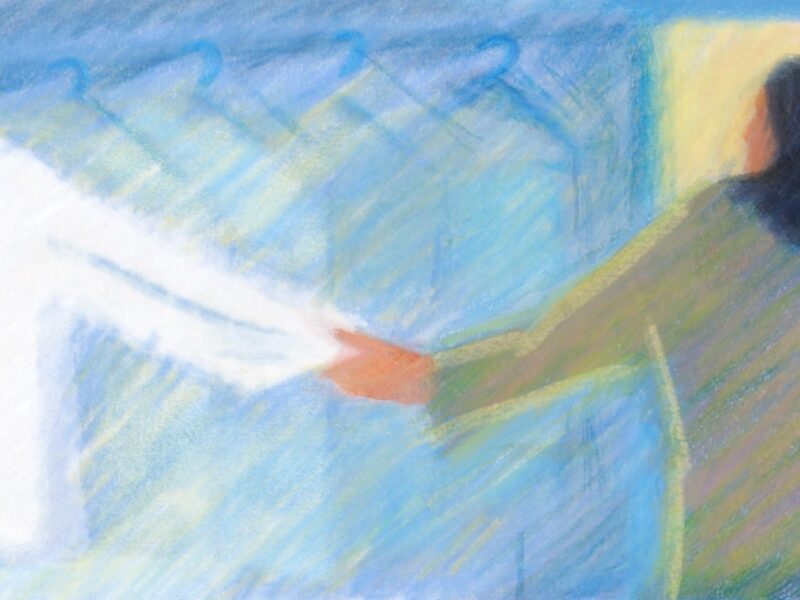An exclusive excerpt from “The Weird Sister Collection,” edited by Marisa Crawford.
I didn’t deign to call myself a feminist until I was nineteen years old, in my second year of college. Before then, I just wanted to be a writer. Reading Judy Blume and the Baby-Sitters Club books obsessively as a kid, I decided I wanted to be an “author” when I grew up, and started writing my own poems and young adult novels in fourth grade (a baby poet at heart, I could never get past chapter two). “Feminist” was a word I rarely heard growing up. If I did, it was mentioned with suspicion at best and disdain at worst. My first encounter with feminism as not purely negative came at fourteen, when my friend’s dad took us to a feminist vegetarian bookstore and restaurant in Bridgeport, Connecticut, called Bloodroot (it’s still there; please go). There, customers brought their own used dishes up to the counter in an apparent rejection of female subserviency that set off a little spark in my brain about the roles of women in the world around me, even if we sort of made fun of it after we left. I bought a bumper sticker that said “Vegetarians Taste Better,” uncertain if the sexual undertone was intended. I also bought a book of poems called Used to the Dark by Vicky Edmonds, a totally obscure small-press work, but the sole example I had at the time of what might be called feminist poetry. Of course, I wouldn’t have used that shameful word, “feminist,” to describe Edmonds’s book—maybe “writing by a woman about the dark parts of how it feels to be a woman,” like so much of my favorite music was? Weird, outspoken women artists like Tori Amos and Ani DiFranco and Courtney Love, who all my boyfriends and boy friends made fun of.
In college when I finally started calling myself a feminist—after meeting cool feminist friends who were nothing like the humorless stereotypes I had been warned about, and who told me I needed to throw out my bleached tampons and listen to Le Tigre and take women’s studies classes—I wanted desperately to make up for lost time, realizing that my whole life had been missing this essential perspective. So I read any and all feminist media I could get my hands on: I borrowed Inga Muscio’s book Cunt from a friend and read it along with every issue of Bitch magazine. I declared a minor in women’s studies and took classes where I learned about intersectionality, agency, privilege.
In my creative writing classes, we never talked about those things; in my first workshop that same year, the MFA student instructor was so infectious in his excitement about literature that I didn’t even notice the syllabus he handed out had zero women writers on it until another female student in the class pointed it out—I was too busy becoming obsessed with Frank O’Hara’s Lunch Poems. Slowly I learned about feminism on a parallel path just next to the one where I was learning about how to be a writer. But I couldn’t quite figure out how these two spaces could coexist, let alone collide, and how on earth to go about building my own life within that collision.
~
Years later, I started the blog Weird Sister in 2014 because these two worlds—the feminist world that was incisive and inclusive, and the literary world that was performative, tongue-in-cheek, and experimental—still felt far too separate to me, even as I entered my thirties. In college, I’d started to see glimpses of the intersections between them: in women’s lit courses where we read Jamaica Kincaid, Toni Morrison, Maxine Hong Kingston, June Jordan, Gloria Anzaldúa. I went to see Eileen Myles read for extra class credit. I found Arielle Greenberg’s Small Press Traffic talk “On the Gurlesque” on the internet one night. Each piece of the feminist literary puzzle I learned about blew my mind all over again, and it occurred to me that there was not just one right way but many, many ways to be a feminist writer.
All these rich lineages of literary work and activism were out there, but where were the spaces outside of academia for people to come together to think and talk about them? From the mid-2000s into the 2010s, the blogosphere was where people talked about things. After college, I discovered the blog Feministing and made it my computer’s homepage so I wouldn’t forget to read it every day. That blog—along with other feminist blogs of that era like Crunk Feminist Collective, Everyday Feminism, Black Girl Dangerous, Tiger Beatdown, Racialicious, and the Women’s Media Center blog—offered supersmart, inclusive takes on politics and pop culture in an accessible, conversational tone that helped me and so many other young people better understand the world. But they didn’t often include literary content—how could they, strapped as they were with the task of breaking down the entire world for young feminists, and payment-free at that? When these spaces did cover books, they were more commercial publications, not the niche within-a-niche world of experimental poetry where I had found my home as a writer.
At the same time—but in a separate sphere—lit blogs were where my particular literary world found community and dialogue on the internet. On blogs like HTMLGiant, Coldfront, The Rumpus, and We Who Are About To Die, poets and experimental writers wrote and read about the small poetry presses and underground literary culture that rarely got covered in larger venues. I remember reading some posts that addressed feminist issues by writers like Roxane Gay and Melissa Broder, then still aspiring writers themselves, but more often I read a lot of posts by cis white men that were interesting, insightful, and funny but lacked the political analysis I was looking for about how poetry related to gender and race and the other aspects of identity and power that mattered most when it came to living in the world.
These indie lit blogs were mostly edited by men and featured long rosters of mostly male contributors, mirroring the gender disparities of more mainstream literary publishing outlets and gatekeepers of the time. Of course there were, thankfully, some exceptions. Pussipo (later renamed HemPo), a collective of 160 feminist poets, started the blog Delirious Hem in 2006, which featured feminist poetics forums, roundtables with feminist small presses, feminist poets writing about everything from rape culture to movies, fashion, and fitness (“It’s a blog, it’s a poetics journal, it’s a platform. From time to time, a post will appear,” reads the description on the now archived Blogspot website). In 2009 I was forwarded a mass email from poet and professor Cate Marvin called “Women’s Writing Now!” which began “Dear Female Writer.” The email—which explained that Marvin’s panel proposal on Contemporary Women’s Poetry had been rejected by the annual writing conference AWP, while the conference regularly accepted proposals on topics unrelated to women (Birds in Poetry, for example, stands out in the mind from my own years of attending)—was a rallying call for the creation of a whole new organization dedicated exclusively to women’s writing. As a result, Marvin, along with Erin Belieu and Ann Townsend, soon founded VIDA: Women in Literary Arts, and in 2010 the organization began, among other vital literary projects, their annual VIDA Count to draw attention to gender disparities in publishing. With the Count, VIDA was not just critiquing inequities in literary culture but also holding institutions and gatekeepers accountable to do better in a very clear, measurable way.
But as Christopher Soto writes in his piece “The Limits of Representation” (page 113), equity in numbers, while hugely important, is only one measure of progress. I still longed for an intentional, energetic, creative, and community-building space to fill in even just some of the lack of feminist literary commentary online, to bridge a bit of the gap between these two distinct worlds I inhabited, and to disrupt the white male lit-blog industrial complex with an explicitly feminist Blog of One’s Own. Boosted by the encouragement of a girl gang of feminist poet friends (special shout-out to Becca Klaver for helping me get the blog off the ground), I bought a web domain, went into a temporary and never-to-be-replicated fugue state wherein I designed a website, and asked a roster of the smartest, coolest feminist writers I knew to join me in launching Weird Sister.
~
I wanted Weird Sister to be a space for talking about the feminist poems and books that inspired us, the contemporary literature that was doing interesting work around gender and other aspects of identity, the sexist shit that happened in the literary world but that nobody talked about publicly, how the established canon we all learned in school upheld what bell hooks calls the white supremacist capitalist patriarchy, the exciting readings and events going on, and the pop culture we consumed alongside it all with glasses of wine or Dr. Pepper—because we were not, after all, monoliths who existed only within the literary world. Like Becca Klaver writes in her piece about Bernadette Mayer’s poetics of “radical inclusiveness” (page 74), it felt feminist and unapologetic to show ourselves as full people who were not just poets and literary critics but also nostalgists and reality TV watchers and record collectors and parents and teachers and people working to survive in the world.
With Weird Sister, I wanted to create an online platform that was filled with serious ideas, but didn’t feel stuffy and exclusionary like poetry criticism so often can. Emulating the chatty, conversational tone of my favorite feminist blogs, Weird Sister aimed to be open and unpretentious. Vernacular language and oft-ridiculed traditionally feminine speech patterns like saying “like” too much were welcomed and encouraged. And, as on the best lit blogs, conventional criticism, creative forms, and personal elements could all, like, blend together. It was a space to celebrate and encourage dialogue between seemingly divergent aspects of culture, both “highbrow” (poetry, film, visual art, politics) and “lowbrow” (pop music, nostalgia, TV, celebrity gossip), and to take to task those supposed cultural distinctions with a glitter-nail-polished middle finger held high.
When it came to the blog’s name, I wanted to invoke the ineffable, the interplanetary; the glittery liminal spaces that art comes from. The “Weird Sisters” are the three witches in Shakespeare’s Macbeth, double double-ing and leading the play’s hero to his demise. They’re prophets, goddesses, bearded hags stirring a glowing cauldron. A weird sister is also an outcast, a goth girl, a nerd, a poet. Her existence is a disruption to the status quo. In my own family, I always felt like the weird one—sandwiched between my two sisters, the art-y and sensitive one traced in heavy black eyeliner. Seeing other “weird” girls and women and femmes in pop culture growing up made me feel seen and inspired.
Weird Sister emerged as a space where we and others like us could see ourselves reflected back, and where we could hang out together and talk and write and multiply; a weird sister to both the more journalistic feminist blogs and the less feminist lit blogs that came before us. A platform and community of feminist poets and creative writers, many of whom were trying out writing critically for the first time in a collaborative blog space, all of whom have gone on to do so many incredible things in the literary world.
~
I didn’t realize it at the time, but in 2014 we were on the precipice of a cultural sea change. When Beyoncé performed at the VMAs the next year alongside a giant glowing “FEMINIST” sign and a sample from Chimamanda Ngozi Adichie’s TED Talk “We Should All Be Feminists,” it made me wonder if a column debunking stereotypes about feminist poetry was even still necessary. In a turn toward what writer Andi Zeisler calls “marketplace feminism,” everywhere you looked people were suddenly wearing feminist T-shirts bought from indie retailers or from H&M, drinking from feminist mugs, meeting at feminist co-working spaces. There was also a huge influx of mainstream, corporate-funded feminist publications and content popping up online. Broadly, VICE’s women’s imprint, launched in 2015. (I both was miffed by their tagline, “Women’s news you thought would exist by now,” and longed for them to hire me.) Lena Dunham and Jenni Konner teamed up to create Lenny Letter that same year. Bustle, Rookie, and xoJane had all launched a few years earlier, and the media landscape was suddenly flooded with women’s personal stories and lists of “ten feminist novels to read this summer.” Most of these publications folded by 2019—a testament to the tumult of the industry, but also to the fleeting nature of corporate interests in feminism as a cultural fad. Many of the original trailblazing feminist blogs and magazines of the 1990s and early 2000s—like Bitch and Feministing—have also since folded, a testament to the difficulty of sustaining an independent feminist project without sufficient funding.
But of course the cultural and social activism of the mid-2010s was about much more than just corporate co-opting of feminism, something that’s been happening since the dawn of the women’s movement itself. Between 2013 and 2015, in response to non-indictments of the murderers of Trayvon Martin and Michael Brown, the #BlackLivesMatter hashtag created by Alicia Garza, Patrisse Cullors, and Opal Tometi became recognized as a protest movement on a global scale. And #MeToo, the campaign started by Tarana Burke in 2006 to draw attention to sexual assault, was popularized as a viral hashtag in 2017. Around this time, my own writing community also began having vital conversations about inclusion, abuse, race, and gender on a scale I had never seen before. In 2015, for example, Marcelo Hernandez Castillo, Javier Zamora, and Christopher Soto founded the Undocupoets Campaign—and later a fellowship with the same name—to protest the discriminatory rules of many first-book publishing contests in poetry, which prohibited undocumented poets from applying. And after several high-profile conceptual poets were called out for racist performances, an anonymous collective of poets called the Mongrel Coalition Against Gringpo began sharing online manifestos lambasting what they saw as the white supremacist project of conceptual poetry (or “conpo”). When a number of instances of sexual misconduct came to light in the poetry and Alt Lit worlds, a proto–#MeToo movement, started by feminist poets including myself in cities across the US and beyond, undertook efforts to dismantle a widespread culture of sexual abuse and harassment in poetry and Alt Lit. Jennif(f)er Tamayo, whose literary activism was instrumental during this time in organizing “Enough Is Enough” meetings and discussions on sexism and accountability in the New York poetry community, writes about their commitment to “Being Unreasonable” as a locus for resisting entrenched forms of oppression in our particular literary communities (page 129). Weird Sister was created to encourage dialogue at the intersections of literature, culture, and social justice, and during this transformative moment it served as a space to document some of these conversations as they were happening in literary communities.
A feminist lit blog was never enough, would never be enough, to eradicate the world’s injustices, but being one small piece of the puzzle trying to change things for the better was all we could ever really hope to be. Writing this in 2023, I can’t say that I feel particularly hopeful about the state of the world. But I think about an interview with Jia Tolentino in 2022 where she says that she can accept hopelessness as a feeling, but never as a political standpoint, and I feel inspired by the continued work of all the writers gathered in this book and at work beyond it—all those “humorless” and hilarious and smart and radical and messy and groundbreaking literary activists that paved the way for us and continue to do so.
When I first launched Weird Sister, I loved the feeling of running a vibrant space where vital conversations about feminism, poetry, and pop culture could flourish. I stayed up late each night working on it between days at my copywriting job—high on the blend of excitement and anxiety—but naturally it was impossible for me and for all of the Weird Sister team to keep doing this work, at this rate, sustainably. And without a model for funding or time to make one, the blog slowly went from a rush to a trickle of occasional content. As Samhita Mukhopadhyay, former executive editor of Feministing, wrote for Barnard College’s 2012 #FemFuture conference on the future of online feminism, “Blogging has become the third shift. You do your activist work, you have a job to make money and then you blog on top of that. It’s completely unsupported.” The feminist blogosphere that Mukhopadhyay refers to is widely considered the hallmark of a whole “wave” of feminism, but—like so much activist work throughout history— it’s had virtually no financial support. Still, in spite of the challenges that came with Weird Sister, it’s amazing to look back on the vast and mind-blowing array of writing that came out of planting this weird little seed on the internet. I hear there’s a movie about baseball where they say, “If you build it, they will come.” I built Weird Sister, and out came all the feminist weirdos with their brilliant minds, and this incredible collaboration and community was born.
~
The Weird Sister Collection brings together some of the most popular, insightful, LOL-funny, moving, and unforgettable posts from the blog between 2014 and 2022, along with some new work highlighting essential perspectives, figures, moments, and movements in feminist literary history. The book pulls out natural themes that emerged from the blog’s eclectic archive: from bringing a contemporary feminist lens to historical literature and paying homage to the iconic writers that came before us, to shining light on current books, events, organizations, and conversations. And, of course, it includes writing about pop culture, both nostalgic and present-day. While never exhaustive, this book hopes to offer a snapshot of some of the vital conversations and commentary surrounding feminism, literature, and pop culture from the last decade, and those that led up to it.
Weird Sister was born out of a love for feminist books, from my longing for feminist books to exist, to line the walls; to read them all, to write them. So it makes sense that it is now a feminist book too. I want feminist literary writing to take up more and more space, both on the internet and in the physical world, on bookshelves where a teenager at a feminist bookstore café might stumble upon them, goddess willing, after bringing her tray up to the counter. And I hope that putting Weird Sister’s contents in a book will allow future generations to learn about the early twenty-first-century feminist blogosphere in a format that gives it the same legitimacy as the white male literary canon; the same weight as the copy of On the Road that my high school English teacher handed me because she thought I might like weird, emotional, experimental prose, and assumed, correctly, that I would ignore how it treated women. The impulse that propelled feminist bloggers in the first place was an interest in creating our own media, holding it up, declaring it real and legitimate and important amid a patriarchal culture that devalued it and gatekept it away. So this book is a reminder that Weird Sister happened, and of the powerful, cool shit you can do together as a creative community. It’s proof that all these feminist writers read books by all these other feminist writers and wrote about them—and about music and movies and TV and art—and then became the feminist writers that others will write about someday. And actually, people are writing about them right now—go read it. Go write it. It’s a never-ending cycle of influence, admiration, and creation. I hope that you find it weird and inspiring.
From “The Weird Sister Collection:Writing at the Intersections of Feminism, Literature, and Pop Culture,” edited by Marisa Crawford. Excerpted with permission of Feminist Press. Copyright 2024 Marisa Crawford.




